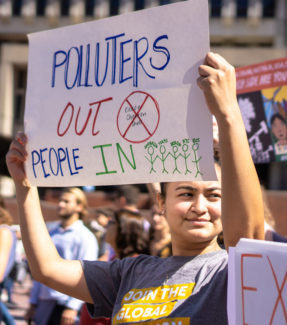The Story of Water: Who Controls the Way We Drink?
Imagine life without a reliable water supply, sewage, or wastewater treatment.[1],[2] You’d probably agree that access to clean, safe water is a human right — right?[3] So why don’t our elected officials seem to prioritize it? The federal government is investing way less in water services than ever before,[4] thanks in part to the efforts of the private water industry.[5]
But water is a public good that relies on public funds,[6] so many cities across the U.S. are facing significant water woes.[7] Short on dollars and stuck with aging infrastructure, these cities have become vulnerable to corporations that swoop in with promises of new pipes and better service for their residents.[8] All these cities have to do is turn over control of their public water systems, to a corporation that will run them with little oversight. What could go wrong? A lot, as it turns out![9]
Corporations offer a variety of privatization schemes,[10] promising they’ll save cities money, but when water is “privatized,” water bills are often much higher than local government-owned utility rates![11] Corporations say they’ll invest in our systems and that service will improve, but cost-cutting to maximize their profits makes that impossible.[12]
Many systems experience frequent main breaks, service disruptions, and even the drastic downsizing of workforces, meaning fewer jobs and people to keep things running safely.[13] And those with the least ability to pay? They’re hit hardest by water privatization.[14] Higher-income communities tend to have better access to services because they can afford rising rates, which only heightens inequality. And what happens if a city wants to break free from a deal gone awry? They often have to buy back their own infrastructure, or pay millions of dollars in termination fees.[15] But it doesn’t have to be this way!
Cities across the country are finding innovative new ways to publicly manage their water systems, so people come first – not profits! Like Philadelphia, where 40% of households were unable to pay their increasing bills.[16] They implemented something called a Tiered Assistance Program, where residents pay a price that’s relative to their incomes.[17] Now, residents can afford essential water services, and their infrastructure gets a much-needed investment, without turning to profit-driven corporations. South Bend, Indiana also avoided privatization, despite needing millions in system improvements. They integrated “smart sewers,” that identify leakage areas and better manage the system, saving them $400 million – enough to keep public control.[18] And Baltimore became the first U.S. city to ban certain forms of privatization, making a long-term commitment to public water.[19]
Let’s spread the word about the hundreds of
successful public water solutions being tested around the country. We know what
really happens when a city turns over this precious resource to corporations.
Let your local officials know that you support public water solutions. And urge
your congress members to reinvest in our water systems nationwide. Let’s send a
message that water is a public good and should not be privately controlled.
Keep our water systems in public hands!
[1] Up to 63 million Americans were exposed to unsafe drinking water in the last decade. https://www.usatoday.com/story/news/2017/08/14/63-million-americans-exposed-unsafe-drinking-water/564278001/
[2] Worldwide, one in four people do not have enough safe water to meet their daily needs. https://www.mdpi.com/1660-4601/9/3/880
This is a human rights travesty. From the disproportionate impact lack of water access has on women and girls to the health risks associated with consumption of unsafe water, this is an issue we must address collectively.
[3] You’re not alone! On 28 July 2010, through Resolution 64/292, the United Nations General Assembly explicitly recognized the human right to water and sanitation and acknowledged that clean drinking water and sanitation are essential to the realisation of all human rights. https://www.un.org/waterforlifedecade/human_right_to_water.shtml
[4] On a per capita basis, federal funding has declined 82 percent since its peak. In 1977, the federal government spent $76.27 per person (in 2014 dollars) on our water services but by 2014 that support had fallen to $13.68 per person. https://www.foodandwaterwatch.org/insight/us-water-systems-need-sustainable-funding-case-water-act
[5] One such example is lobbying by private water giant Aqua America. According to Reuters, “Amid uncertainty over federal financing of infrastructure projects, [Aqua CEO] Franklin said he has been telling Congress not to spend federal money and to let private capital go to work instead.”
[6] The Public Trust Doctrine holds that certain natural resources like navigable waters are preserved in perpetuity for public use and enjoyment. The fact that water is a commons–and that access to it is an internationally recognized human right–underscores the need to protect it from corporate control and ensure all people have it, regardless of socioeconomic status. https://flowforwater.org/public-trust-solutions/what-is-public-trust/
[7] Water infrastructure in the United States is failing. The 2017 Infrastructure Report Card scored the country’s drinking water at a ‘D’ and overall infrastructure at a ‘D+’. It’s no wonder there is a growing movement of people calling on our elected officials to re-prioritize investment in our most essential public service. https://www.infrastructurereportcard.org/cat-item/drinking_water/,
[8] Desperate towns have turned to private water corporations to run their water and wastewater systems. While these corporations’ promise of much-needed upgrades and service improvement are appealing, they all too often fall short. https://www.nytimes.com/2016/12/24/business/dealbook/private-equity-water.html
[9] Unfortunately, the abuses of the private water industry aren’t limited to one community or one privatization model. Here’s a snapshot of the industry’s disastrous track record:
- Flint, Michigan: In February 2015, at the height of the Flint water crisis, the city hired Veolia to study drinking water quality. Veolia declared Flint’s water safe, failed to warn the city of possible lead contamination, and even recommended a chemical change that the state alleges made the crisis worsen. Now, the Michigan Attorney General is suing Veolia for professional negligence and fraud, among other charges.
- Pittsburgh, Pennsylvania: Following management contracts with Veolia, Pittsburgh suffered its own lead crisis that continues to endanger city residents. Under Veolia’s management of the Pittsburgh Water and Sewer Authority, the corrosion control chemical used to prevent lead contamination was switched to a cheaper alternative without the required approval, violating state regulations
- Bayonne, New Jersey: In Bayonne, a PPP deal involving Suez and private equity firm KKR has left residents with skyrocketing rates. The $150 million upfront payment the city received has come at a very high price to ratepayers who are not only paying back that massive sum, but also paying the added cost of investment returns the private sector demands. Some residents struggling to pay their water bills—with rates already increased by nearly 28 percent—have even had liens placed on their homes that could lead to foreclosure.
- Plymouth, Massachusetts: Under Veolia’s operation of the city’s wastewater system, 10 million gallons of raw sewage flooded Plymouth between December 2015 and January 2016, spurring a lawsuit by the state. In April 2018, Massachusetts Attorney General Maura Healey announced that Veolia will pay a $1.6 million settlement. “By failing to properly maintain and operate wastewater treatment facilities, companies like Veolia are not only violating the law, they are threatening public health and our invaluable coastal water resources,” Healey said.
For more information, including citations, on these cases and more:
https://theintercept.com/2018/05/20/pittsburgh-flint-veolia-privatization-public-water-systems-lead/
[10] Privatization schemes range from outright sales to long-term leases to so-called “public-private partnerships” or PPPs. Despite this wide range of schemes, the common thread is a forfeiture of public control (or, in the case of a sale, public ownership) of this essential service to a profit-driven corporation. https://www.foodandwaterwatch.org/sites/default/files/Public%20Private%20Water%20Service%20FS%20Apr%202010.pdf#page=2
[11] Privately owned water systems charge 59 percent more than publicly owned systems, on average. https://www.foodandwaterwatch.org/insight/state-public-water-united-states
[12] In fact, some privatization schemes–like the one Veolia had in Pittsburgh–incentivize cost-cutting as a way for the corporation to maximize its returns by giving it a cut of every dollar it “saves” the utility.
In his audit of the Pittsburgh Water & Sewer Authority–which Veolia managed under this scheme–Pittsburgh City Controller Michael Lamb said the authority “should avoid hiring companies to manage the authority that require a percentage of cost savings. Agreements like this promote the company’s profits over the competent operation of the authority.”
http://apps.pittsburghpa.gov/co/Pittsburgh_Water_and_Sewer_Authority_June_2017.pdf#page=53
[13] From Atlanta to Indianapolis, dramatic staff cuts have followed private takeovers of public water and sewer systems. In a survey of 10 drinking water and wastewater privatizations, corporate takeover led to an average job loss of 34 percent. Service problems frequently plague cities when there are fewer employees available to make repairs and respond to customer concerns. https://www.foodandwaterwatch.org/sites/default/files/privatization_threatens_workers_report_may_2009.pdf
In Pittsburgh, City Controller Michael Lamb found that Veolia recommended “cost savings from reduced staffing at the lab.” This reduction in lab staff to adequately monitor the water quality is even more disturbing when considering that the city is in the midst of a lead crisis following Veolia’s management.
http://apps.pittsburghpa.gov/co/Pittsburgh_Water_and_Sewer_Authority_June_2017.pdf#page=51
[14] Privatization disproportionately hurts low-income individuals and families. By shifting social costs onto the individual, the market logic of “personal responsibility” serves as a pretext for a self-perpetuating spiral of social disinvestment. The higher fees that too often follow privatization are “a highly regressive way of funding public services.” Simply put, privatization increases inequality. https://www.inthepublicinterest.org/report-how-privatization-increases-inequality-2/
[15] Cities around the U.S. are trying to wrest control of their systems back from corporations, usually because of complaints about poor service or rate hikes. Since these corporations are rarely willing to surrender these lucrative deals, they can end up in court where city must prove that ownership is in the public’s interest. The public then pays a price determined by the court. Those prices can be exorbitant, which underscores the danger of turning to these corporations in the first place. https://www.washingtonpost.com/national/health-science/towns-sell-their-public-water-systems–and-come-to-regret-it/2017/07/07/6ec5b8d6-4bc6-11e7-bc1b-fddbd8359dee_story.html
[16] 40 percent of the city’s water utility ratepayers were unable to pay (or behind on payment of) their water bills, amounting to about $242 million in uncollected revenue, according to the Philadelphia Water Department. https://www.governing.com/topics/transportation-infrastructure/gov-philadelphia-income-based-water-bills.html
[17] One in five Philly residents, disproportionately Black and Latino households, have had their water disconnected at least once since 2012 as a result of falling behind on their water payments. With the Tiered Assistance Program (TAP), a resident’s monthly water bill is not based on their consumption but rather set as a percentage of their household income and size. Once enrolled, TAP participants do not have to make payments on the outstanding balance while in the program. Residents are eligible for balance forgiveness after two years of punctual payments.
[18] In South Bend, Indiana, the start-up EmNet–formed in partnership with the city–has installed more than 150 sensors that gather information about water flow and rainfall. This data, combined with predictive weather data, is crunched and analyzed in order to provide real-time decisions about water flow. Since implementing the system, South Bend has reduced wastewater overflow by a billion gallons per year. All told, the city is cutting nearly $400 million out of a $600 million proposed infrastructure overhaul by using this technology. Instead of building the proposed sewage tanks and a new water pipe, the city can take better advantage of the infrastructure that’s already there. https://qz.com/825213/has-your-drinking-water-been-digitized-connected-technology-has-hit-water-management/
[19] The city of Baltimore voted overwhelmingly to ban the privatization of its water and sewerage systems, the first large U.S. jurisdiction to take such a step. Around 77 percent of more than 148,000 voters backed a proposal to prevent the city from selling these systems–after years of private water corporations attempting to privatize–in a major win for public control of our essential services. https://www.reuters.com/article/us-usa-water-cities/baltimore-votes-to-become-first-large-u-s-city-to-ban-water-privatization-idUSKCN1NC2O4



